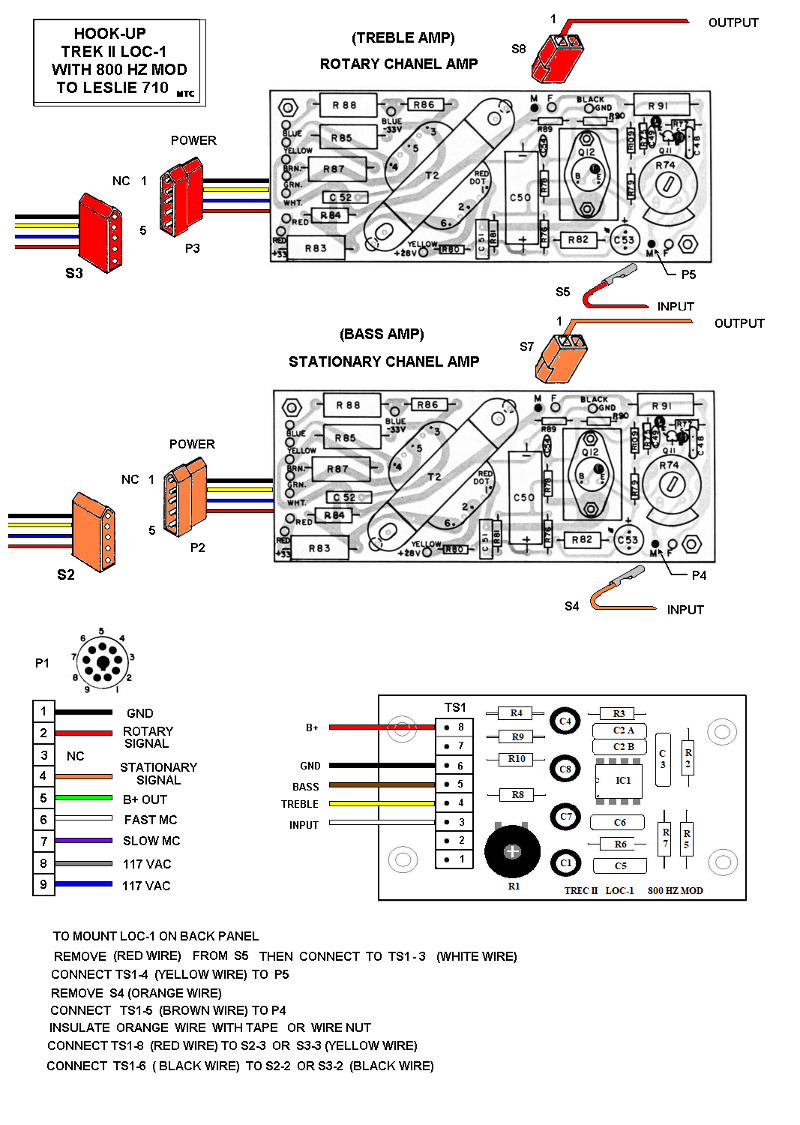The following write-up was posted by MikeCasino to TheHammondForum. It describes modifications made to a Leslie710 to convert it for use with a (single-channel) Hammond.
It might be a bit trying to find a electronic Leslie crossover, but there is an electronic crossover available from Trek that fits the bill with a little modification. This is the  Trek II LC0-1 electronic crossover modeled around portions of BobSchleicher of ElectronicInstrumentService "UniversalLeslieAdapter". I put it this way only because the ULA has older type op-amps.
Trek II LC0-1 electronic crossover modeled around portions of BobSchleicher of ElectronicInstrumentService "UniversalLeslieAdapter". I put it this way only because the ULA has older type op-amps.
The original concept of the ULA and Trek II are to adapt two channel Leslies to single channel organs using that Leslies original configuration. Not a bad sound but for me since I like to use the Leslie to really accent my playing, the spin up and down time of the heavy RotosonicDrum took too long.
The basic differences between them are frequency cutoff points, amount of cutoff or (roll off), power supply requirements and master volume control placement. First lets take a look at frequency cutoff points. Keep in mind that the popular Leslie tube amps have a cutoff point at 800 Hz or there abouts.
The original 760 active Leslie crossovers actually have a roll-off of 12dB/oct - they are 2nd order Butterworth filters. The nominal crossover frequency gives approx. 859Hz. ((L.M.V.)(M.T.C.)corrected 10/30/07)
The drawing for the ULA electronic crossover cuts off at 150 HZ with a 12 dB per octave roll off and uses a double power source. since you build this your self, you can mount the master volume where you want, but you will also need to supply a plus and minus power supply for this one.
The Trek II electronic crossover also cut off at 150 Hz with a 12 dB per octave roll off and uses a single power source right from the Leslie. The master volume is located on the circuit board, but can be modified to mount elsewhere.
For a simple clarification the more dB per roll off, the faster those frequencies are not transferred to the place it should no t go.
I used the Trek II and modified it not only because of the good design but the ease of the modification. By replacing and adding only nine components (resistors and capacitors) now I have a 800 Hz electronic crossover with 12 dB per octave roll-off. It uses the Leslie's power supply which is a less of a hassle. The instruction that are supplied with it are clear and easy.
Warning! |
A reliable source has reported that the component values listed here will result in a crossover frequency of 80 Hz rather than 800 Hz. Please double-check the calculations before attempting the modifications described here. (Not having access to the full schematic for the LC0-1, I can not check the calculations myself.) -- JeffDairiki Part change and additions corrected below -- Mike Casino
1) 28K ohms 1/4 watt.
3) 14K ohms 1/4 watt.
5) .01 micro farad caps.
Replace R2, R3 & R6 with 14K ohm resistors.
Replace R7 with 28K ohm resistor.
Replace C2 with two .01uF caps in parallel.
Replace C3, C5 & C6 with .01uF caps.
This will give you a crossover of 803 Hz.
Now for the lower Rotor assembly: I found one on eBay and mounted it under the 15" speaker and then inverted the lower motor assembly. There are a couple of rotor assemblies that can be used for the 15" speaker. The preferred one is ten inches in height and the second choice is one inch shorter. The shorter rotor can be blocked up from underneath. Since the Leslie 710's lower motor spins in the same direction as the upper motor, and I wanted the same effects as the big boys, I inverted the motors, changed the hardware around on the slow motor and cut a channel in the sounding board for the belt. You may be thinking to yourself that the 710 already has a belt to drive the rotor. It does but it is shorter, so I replaced it along with the spindle so the lower rotor spins at the same speed as the big boys. Since I was a little lazy, I did not invert the sounding board to place the 15" speaker on the right hand side of the Leslie, so I had to mount the power supply on the right hand side and shim out the amplifier plate 1/4 of an inch for safer clearance.
The results are awesome. I would take this unit over any 760 / 770 any day!
Hook up information can be viewed here: 
The content of this page is Copyright (C) 2000, 2001, 2002 Geoffrey T. Dairiki and
the other authors of the content, whoever they may be.
This is free information and you are welcome redistribute it
under certain conditions; see
http://www.dairiki.org/HammondWiki/opl.html for details.
Absolutely no warrantee is made as to the correctness of
the information on this page.